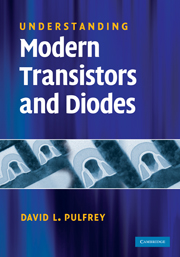Book contents
- Frontmatter
- Contents
- Preface
- 1 Introduction
- 2 Energy band basics
- 3 Electron and hole concentrations
- 4 Thermal equilibrium
- 5 Charge transport
- 6 np- and Np-junction basics
- 7 Solar cells
- 8 Light-emitting diodes
- 9 HBT basics
- 10 MOSFET basics
- 11 HJFET basics
- 12 Transistor capacitances
- 13 Transistors for high-speed logic
- 14 Transistors for high frequencies
- 15 Transistors for memories
- 16 Transistors for high power
- 17 Transistors for low noise
- 18 Transistors for the future
- Appendices
- Index
14 - Transistors for high frequencies
Published online by Cambridge University Press: 05 June 2012
- Frontmatter
- Contents
- Preface
- 1 Introduction
- 2 Energy band basics
- 3 Electron and hole concentrations
- 4 Thermal equilibrium
- 5 Charge transport
- 6 np- and Np-junction basics
- 7 Solar cells
- 8 Light-emitting diodes
- 9 HBT basics
- 10 MOSFET basics
- 11 HJFET basics
- 12 Transistor capacitances
- 13 Transistors for high-speed logic
- 14 Transistors for high frequencies
- 15 Transistors for memories
- 16 Transistors for high power
- 17 Transistors for low noise
- 18 Transistors for the future
- Appendices
- Index
Summary
The large-signal models of Fig. 13.16 and Fig. 13.19 are to be used when considering DC and switching operations. High-frequency operation is governed by the small-signal performance of transistors. It is insightful, and computationally efficient, to develop a small-signal model of the transistor by linearizing the large-signal model. Our approach is to linearize via a Taylor series expansion, and then manipulate the resulting equivalent circuit so that it can be used to define and evaluate two important high-frequency metrics: fT and fmax.
Small-signal operation is illustrated in Fig. 14.1, which shows a simple amplifier. The base-emitter DC bias is supplied from the power-supply VBB via a resistor, and the small AC signal is supplied from vin via a capacitor. The transistor is of the bipolar variety, in recognition of the fact that bipolar transistors (BTs) have traditionally been dominant in high-frequency applications. This dominance has been due principally to the BT's transconductance being inherently superior to that of FETs, as we will show later in the chapter.
Presently, the world record for fT is 710 GHz, and is held by an HBT based on the sleek-looking device shown in Fig. 14.2. However, nowadays, FETs are encroaching into the high-frequency domain: HEMTs using high-mobility semiconductors based on GaAs and InP can yield devices with very high transconductance; and MOSFETs employing silicon's matchless technology can yield very small devices, for which the capacitance is very low.
- Type
- Chapter
- Information
- Understanding Modern Transistors and Diodes , pp. 251 - 272Publisher: Cambridge University PressPrint publication year: 2010



